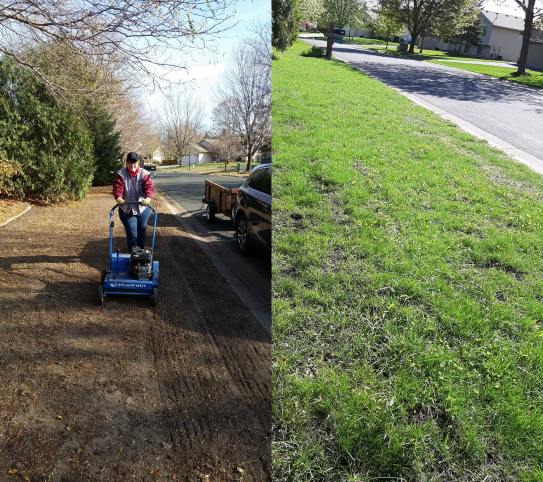Welcome to the latest issue of the Home Lawn Care Newsletter from UMN Turfgrass Science! We will provide monthly updates to address all your lawn care tasks at the times when you need to know.

Sept 16, 2022: Issue 5
The Turfgrass Science team from UMN spent a lot of time answering questions at the Great Minnesota Get Together. Here are a few tips on weed identification, turfgrass species, dormant seeding and bee lawns that we offered homeowners during our twelve days at the fair.
I love the yellow "clover" in my yard

White clover, black medic and yellow woodsorrel
Heard frequently at the State Fair, it seems this is a good time to talk about identifying weeds such as white clover, black medic and yellow woodsorrel before we treat them. White clover and black medic are non-native to Minnesota.
Dutch white clover (Trifolium repens) is the common clover found in Minnesota lawns. It's readily identified by the rounded white flower head and leaves consisting of three leaflets that typically show a white crescent. This clover is a short-lived perennial, spreading by both stolons (above-ground horizontal stems) and seeds. It tolerates short periods of drought, pet burns and light food traffic, in addition to fixing nitrogen in the soil.
White Clover from UMN Extension
White Clover from Purdue University
Frequently mistaken for white clover are two yellow-flowering weeds that also have leaves consisting of three leaflets.
Black medic (Medicago lupulina) is in the legume family like clover. It also fixes nitrogen in the soil. The flower is a smaller and yellow version of white clover. In addition to the yellow flower, black medic has an extended petiole (stalk) on the middle of the three leaflets, and this extended stalk is a key identifier. It is an aggressive summer or winter annual weed that in warmer climates may be perennial because of a long tap root.
Black Medic from UMN Extension
Black Medic from Purdue University
Unrelated to clover, yellow woodsorrel (Oxalis stricta) is late to germinate. It readily fills any gaps in the lawn in mid-summer. It also spreads by seed and stolon, and can be an annual or perennial in this climate. Exploding seed pods have 20-50 seeds on average and each plant potentially has over 5,000 seeds each year. Yellow woodsorrel can easily be identified by the five-petaled flower and three distinctly heart-shaped leaflets within each leaf.
Yellow Woodsorrel from Minnesota Wildflowers
Yellow Woodsorrel from Purdue University
What kind of grass should I plant?
There are many considerations when choosing grass seed. Generally, fine fescues (Chewings, hard, strong creeping red, slender creeping red and sheep) as well as tall fescue will tolerate shade better than Kentucky bluegrass. Typically, even shade-tolerant grasses prefer 3-4 hours of sun per day. These shade-tolerant grasses can also tolerate full sun. In situations where you might expect more ice cover during the winter, such as where standing water is common during snow melt, you should avoid using tall fescue and Chewings fescue.
Lower input grasses like all fescues are excellent replacements for Kentucky bluegrass. They require significantly less water, fertilizer and mowing each year. A mowing or two and no additional watering or fertilizer is common. Fine fescues are somewhat less tolerant of heavy foot traffic, but tall fescue is able to handle a lot and is now found frequently in turfgrass sports fields in a ratio of 90% tall fescue to 10% Kentucky bluegrass. Turf-type tall fescues blend well with Kentucky bluegrass in appearance and texture.
Seeding and sodding home lawns from UMN Extension
Which fine fescue should you use?
When seed is short, the solution is tall (fescue)
Turfgrass suggestion for the Twin Cities a video
When and how do I plant grass seed?
Late summer is typically the best time to seed, whether starting an entire lawn or overseeding. The weather from mid-August to early-mid September is perfect for establishing a new lawn before frost. We've passed the ideal time for seeding as of this week, but the other option for this year (rather than wait until spring) is very easy. It's called dormant seeding, and is done when the soil temperature is around 40 degrees, typically in mid-November.
The biggest benefit to dormant seeding is that watering three times a day until seedlings are established is not necessary. The process for dormant overseeding into an existing lawn requires mowing low (to 1-2 inches) and removing clippings. Then, using a vertical mower or heavy garden rake, loosen the soil where you'll be seeding. Add seed, and lightly rake using a spring rake to create good seed-to-soil contact. Leave 10-15% of your seed showing. Especially when sowing fescues, no starter fertilizer is necessary. Do not water a dormant seeding. Instead, sit back, look forward to a little snow pack to settle the seed into the soil, and come spring you'll have a new lawn. Depending on how the winter goes, minimal overseeding may be required in the spring. If you're starting a new lawn, or have an area where sod has been removed, you can start at the vertical mowing step above. Get more details by following the links below.
The perfect time to dormant seed lawns in MN
Dormant seeding from UMN Extension
Consider dormant seeding your lawn this fall
Bee lawns are a new favorite

Dormant seeding a bee lawn in November and the same site in spring.
At the fair, we showcased fine fescues, self heal (a native plant), Dutch white clover, and creeping thyme, which are plants that go into a bee lawn. This selection of plants was made by a team including former UMN graduate students, and is frequently referred to as the UMN Bee Lawn blend. There are other bee lawn mixes, including native flowering plants, available. Flowering plants for bee lawns tolerate mowing at 3.5 to 5 inches and still bloom. They also share characteristics of drought tolerance and similar levels of handling foot traffic. Bee lawns are an easy choice for encouraging bees - both native bees and honeybees. Dutch white clover alone supports over 55 types of bees; the mix of flowers extends the flowering season as well.
Bee Lawn seed is very easy to install using the dormant seeding method described above. More information about installing and maintaining bee lawns can be found at the links below.
Bee lawns: installing and maintaining
Planting and maintaining a bee lawn from UMN Extension
New bee lawn resources from Extension from Purdue University
Apply for a Lawns to Legumes grant from Blue Thumb
Event
Research Highlights
We know that bee lawns are an extremely popular topic with people in Minnesota based on how many questions we received during our time at the Minnesota State Fair. Much of what is recommended for bee lawns is based on research by former graduate students from the Turfgrass Science and Bee Lab groups. If you would like to learn more about the UMN research behind bee lawns, please read these articles by our former graduate student.
Weeds in the Turf Lawn: Invasive Nuisances or Sources for Forage? by James Wolfin
If you build it, who will come? Evaluating the diversity of bees in flowering lawns by James Wolfin